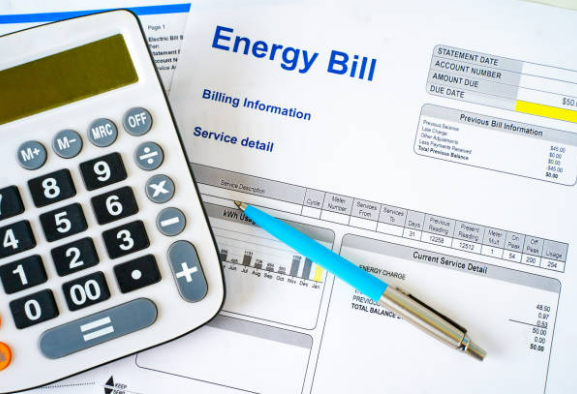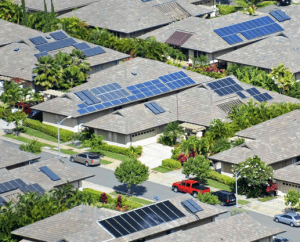Everything you need to know about net metering
Net metering started in 1996 in California to incentivize solar panel installations by offering credit for selling energy back to the grid. It’s the billing process that reimburses both residential and commercial solar energy system owners for their unused electricity.
What is net metering?
Customers that have PV (photovoltaic) systems or solar panels installed may find that they generate more power than they typically use during the day. In this instance, if the home or property is net-metered, the electricity meter will run backwards, providing credit against the electricity consumed when it exceeds the amount of energy generated.
Solar net metering works by selling any unused or surplus power to your utility operator in exchange for credits. In turn, these credits offset any electricity you may need to use from the grid.
How does net metering work?
Net metering involves tracking the electricity generated by solar panels so that a commercial or residential customer can supply any excess energy to the electric grid. The utility company that the property is registered with will then reimburse that user for the energy.
Here’s a breakdown of how it works:
Step 1. Your solar panels convert energy from the sun into direct current (DC) electricity
Step 2. Your inverter converts the DC current into alternating current (AC) electricity
Step 3. That electricity is used to power your house or office building
Step 4. Any surplus electricity flows into the main electrical grid for others to use
Step 5. Your meter tracks the inflow and outflow of energy to and from the grid
Step 6. Any excess power is credited to your account
Solar panels and PV systems generate the most electricity during the middle of the day when the sun is at its highest point and shining brightly. However, this is usually when properties use the least energy. For example, commercial properties will use less electricity in the middle of the day when people are taking their lunch break, while residential properties are often unoccupied during the day because people are typically at work, running errands or attending classes. So it’s fairly likely that your solar panels will be generating much more electricity than is needed at that time.
This excess energy needs somewhere to go, and so it gets sent back into the grid for others to use. When this happens, your electric meter spins backwards, providing you with an electricity offset. Then, when your solar panels aren’t producing any electricity during the night, you begin taking energy from the grid — and your electric meter spins forward again.
When the bill is delivered at the end of the month, your utility company nets how much electricity you used from the grid, versus how much you sent back.
Types of net metering
There are three different types of net metering:
- NEM 1.0
- NEM 2.0
- NEM 3.0
NEM 1.0 applies to any customer who signed up for net metering before July 1st 2017. This type of net metering package includes:
- Non-bypassable charges
- A $1 monthly connection fee
- Average savings of $245 per month for a ten kilowatt system
NEM 2.0 applies to those who signed up to net metering after July 1st 2017. It was brought in to increase sales of solar installations and the number of solar energy jobs by locking customers into a 20-year rate plan. The NEM 2.0 package includes:
- Bypassable charges of $0.02 per kilowatt-hour
- A $75 one-time connection fee
- A $10-20 monthly connection fee
- Average savings of $204 per month for a 10 kilowatt system
NEM 3.0 is slightly different, because it was developed to incentivize solar-plus-storage systems that focus on keeping and consuming energy at the same site it was generated in – as opposed to selling it back to the grid.
NEM 3.0 was approved on December 15th 2022. This decision saw the start of a 120-day sunset period for NEM 2.0, meaning utility customers have until April 13th 2023 to submit interconnection paperwork.
NEM 3.0 includes:
- Bypassable charges of $0.04 per kilowatt-hour
- A $8 monthly connection fee
- A fee of $12-16 per month for Southern California Edison and San Diego Gas & Electric customers, or $48-64 per month for a typical system
- Average savings of $70 per month for a ten kilowatt system
NEM 3.0 will require customers to enroll in Time-of-Use rates, which are most expensive later in the day when panels aren’t generating the maximum amount of energy. However, new installs may be paired with a battery that can store energy generated in the day to use in the evenings and at nighttime.
Which states offer net metering?
Many states have passed net metering laws. However, while some states may offer net metering voluntarily, others have to offer it as a result of a state-imposed regulation. Because legislation and regulatory requirements vary so widely between states, net metering and compensation for solar energy can look very different depending on where in the US your property is located.
The states offering net metering credits include:
|
Alaska American Samoa Arkansas Colorado Connecticut Delaware Florida Guam Iowa Kansas |
Maine Maryland Massachusetts Minnesota Missouri Montana Nebraska Nevada New Hampshire |
North Carolina North Dakota Ohio Oklahoma Oregon Pennsylvania Puerto Rico Rhode Island South Carolina |
Virginia Washington Washington, D.C. West Virginia Wisconsin Wyoming U.S. Virgin Islands Vermont New Jersey New Mexico |
However, California, Illinois, Indiana, Kentucky and Michigan are transitioning from net metering to a different form of compensation. For example, some are beginning to set crediting structures based on dollar value, rather than kilowatt-hour netting. While others are reassessing NEM 2.0 tariffs against the newly passed NEM 3.0.
Seven states, including Arizona, Georgia, Hawaii, Louisiana, Mississippi, New York and Utah have mandated some form of compensation but do not offer net metering. While the 10 remaining states do not have any mandates, some utility suppliers do still offer net metering in those regions.
To be sure about any policies or changes that might impact you, it’s always best to check the most up-to-date regulations for your specific state.
How does net metering affect energy bills?
In short, net metering allows you to make money back on any energy that your solar panels generate but goes unused by your household or property. It also offsets any electricity you take from the grid. In fact, panels that have enough surface area for the given property may actually help users offset the majority of their electricity costs. Rates are decided within the agreement signed between the PV system owner and the utility provider.
Is net metering worth it?
By 2050, it’s predicted that solar will account for 36% of the world’s electrical generation. Net metering can be a valuable incentive to encourage both residential and commercial customers to purchase solar panels or PV systems. And depending on whether you’re on the NEM 1.0, 2.0 or 3.0 package, net metering can even be profitable.
It also means that sustainability isn’t one of the only benefits of installing solar panels, but also that it can save you money in the long run and reduce your reliance on the main electrical grid. Now that NEM 3.0 has been accepted, it could mean users begin to see the overall profitability of net metering decline over the coming years, but they will still undoubtedly benefit from their own supply of energy, as well as saving money on energy bills.




